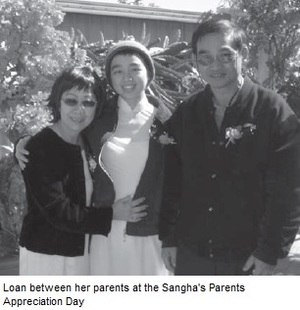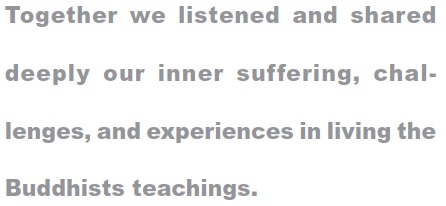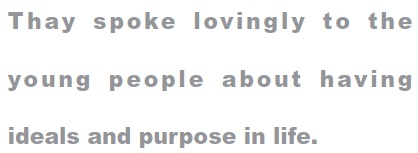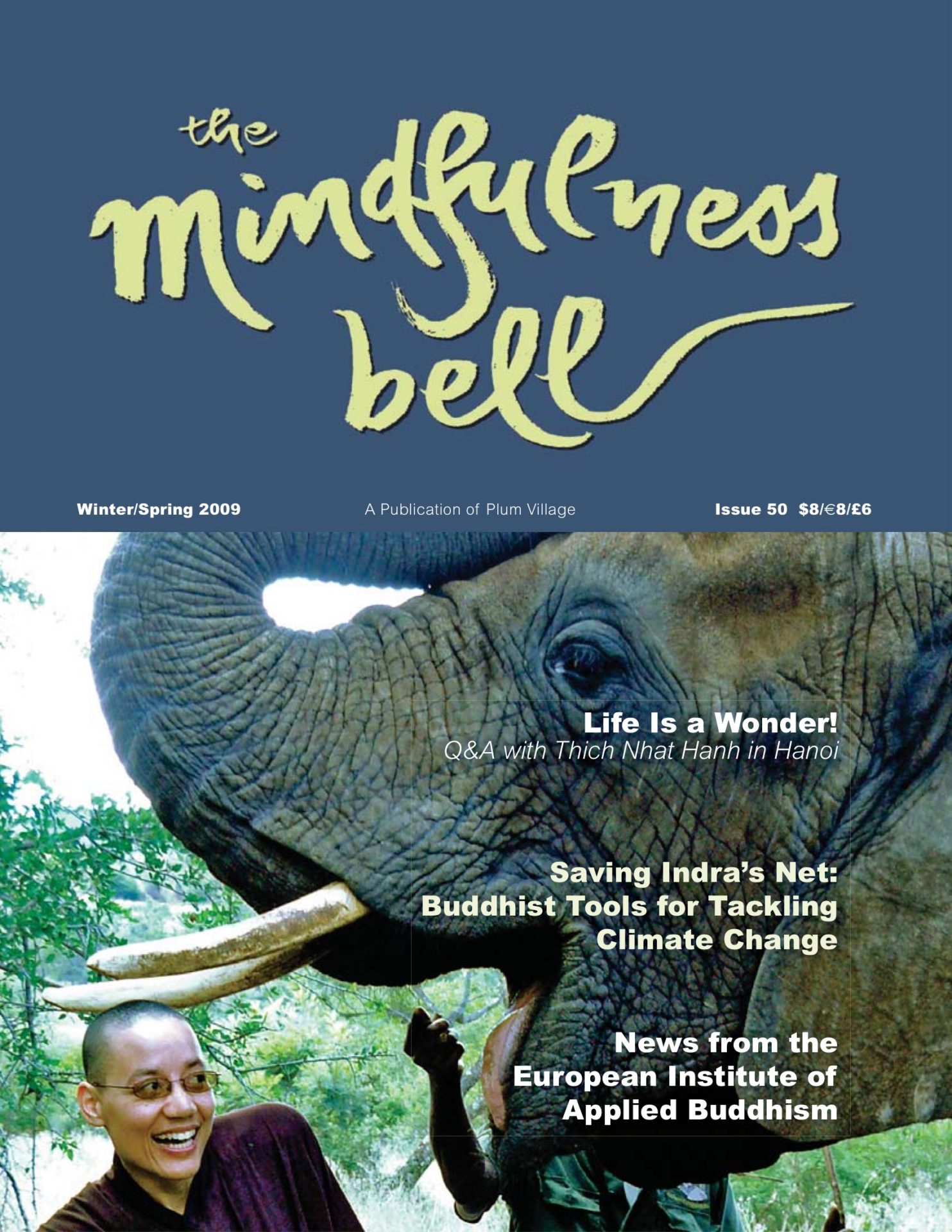
By Loan To Phan

I am a Vietnamese-born Australian citizen. While attending a winter retreat at Plum Village in November 2007, I got in touch with my ancestral roots on a level that over the last twenty-three years has been unacknowledged and unexplored, almost foreign. “Boi dap goc re, khai thong suoi nguon” (nourishing our roots, clearing our streams) were the themes at Plum Village that awoke a deep gratitude and curiosity about my blood ancestors.

By Loan To Phan

I am a Vietnamese-born Australian citizen. While attending a winter retreat at Plum Village in November 2007, I got in touch with my ancestral roots on a level that over the last twenty-three years has been unacknowledged and unexplored, almost foreign. “Boi dap goc re, khai thong suoi nguon” (nourishing our roots, clearing our streams) were the themes at Plum Village that awoke a deep gratitude and curiosity about my blood ancestors. I realized that my existence came from a life force that runs through my parents, grandparents, and continuing back and back through many generations before them.
Growing up in a generally individualistic society has distanced me from my roots. Ironically, this has created a blank space that allows me to bring a beginner’s mind to explore and understand myself through knowing my ancestors. What better way to find answers to these questions than a trip to Vietnam?! And what better conditions than Buddhist retreats — with opportunities to deeply contemplate myself and hence my ancestors in me?! It was particularly meaningful to be able to do this with my parents.
Dharma Rain at Bat Nha
The first retreat with Thich Nhat Hanh or Thay (Vietnamese for Teacher) was a five-day retreat at Prajna Monastery in Bao Loc, Lam Dong province. The spacious monastery and temperate weather of the green highlands near central Vietnam were ideal conditions for practice. In total there were approximate 3500 people of all ages attending this retreat. I was surprised to see so many young people there, some as young as fifteen — students and young people working in business, film industry, social work, health, etc. They all shared a search for meaning as well as relief from the difficulties faced in their increasingly demanding and pressured environment.
Vietnamese people really enjoy socializing; in particular they like to be lively and vocal. However, during meals together and walking meditation all one could hear were the click-clacking of plastic cutlery and crockery, or the melodies of bird songs and rustling of leaves.
Thay spoke lovingly to the young people about having ideals and purpose in life, recounted funny love stories, and explained how having values or guiding principles as outlined in the Five Mindfulness Trainings can help restore and improve the quality of our relationships. He urged the young people to be determined and diligent in their practice of returning to the present moment by focusing on their breathing as they go about daily tasks. He explained how to listen deeply to cultivate understanding and Beginning Anew, a practice of reconciliation and expressing hurt in a constructive way. Brother Phap An gave a compelling account of his personal experience in dealing with a block of suffering he had gained during his childhood as a result of the war. Brother Nguyen Hai’s explanation on the Five Mindfulness Trainings contributed to inspiring about a third of participants to take the commitment to study and practice the Mindfulness Trainings and take refuge in the Three Jewels.
The regular afternoon exercise time came to life with traditional Vietnamese games such as bamboo stick jumping and Vietnamese hacky-sack, singing songs of meditation and joyful practice, or just walking around the beautiful gardens of Prajna.
The question-and-answer session contained some queries about forming and maintaining a Sangha for young people.
As a Viet-kieu I was impressed at the openness, depth and wisdom my young Vietnamese friends had drawn from their experiences. For some, Thay’s Dharma talk was a confirmation of their hard-earned life lessons, while for others the retreat planted a seed of curiosity about what it means to live engaged Buddhism.
The pouring monsoon, symbolising Dharma rain, came down generously as we shared deeply our experiences of life’s challenges and successes during Dharma discussion groups. The tents that we slept in became soaked but it didn’t dampen our spirits. We just rolled up our sleeping mats and joined the snoring choruses of the “young at heart” participants in the main meditation hall. In fact, the hard floor, lack of sleep (because it was colder than expected so some of us could not get good sleep) actually made our memories of the joy and peace in newly found friendship even more memorable!
Retreat for the Young People of Hanoi
Continuing their tour to the north, Thay and the Plum Village delegation held another four-day retreat for the young people of Hanoi, at Bang Temple, Hoang Mai province. Bang Temple was still under construction when over a thousand people crammed into its grounds, overtaxing its already limited accommodation and sanitary facilities. I was particularly moved to see elderly women bent over from their hard laboured life as well as young people from well-to-do families determined to receive the Dharma so much that again, the wet weather, hard floors, simple meals did not deter them from fully participating in the mindful practices.

My Dad, who only attended the last session and lunch, was moved to tears by the collective energy of the four-fold Sangha eating mindfully. The walking meditation through the narrow local streets brought curious faces to the doors, preschool children offering their joined palms in respect and bright smiles as the river of Sangha flowed past, silent and reverent.
A highlight of this retreat was the session between young people and young monastics of Western and Vietnamese background. There was lively singing that accompanied eager questions about monastic life and faith. These questions illustrated the young people’s collective responsibility through concerns about their future as a generation facing the challenge of living in a society with increasing materialism and consumerism, corroding morality, and where Buddhism is a religion rather than a way of life and practice. The question-and-answer session with Thay was also dominated by questions from young retreatants about monastic aspirations and how to deal with the tribulations of romantic love.
Busy Hotel to Tranquil Monastery
There couldn’t be more of a contrast between the last two retreats and the twelve-day retreat titled “Engaged Buddhism for the Twenty-First Century” held at the Kim Lien Hotel in central Hanoi. This included the UN Day of Vesak 2008 and a three-day conference on the theme “Buddhist Contributions to Building a Just, Democratic and Civil Society.”
I went from a traditional incense-perfumed, spiritual environment with austere facilities to a relatively affluent, Western, secular hotel in downtown Hanoi. From sleeping on the floor and using squat toilets to serviced beds in air-conditioned rooms — I realised how attached I am to Western creature comforts! I am amazed at how in both of these environments the mindful practices can create wonderful and joyful energies, which confirms the universal nature of the Buddha’s teachings.
I am blown away at how a few simple collective practices of over four hundred participants from forty-one different countries can transform a busy worldly hotel into a tranquil monastery (not that there are any real differences in the ultimate sense!).
This retreat was special in that there was an ordination ceremony for the Order of Interbeing with over fifty people committing themselves to living the Fourteen Precepts, and close to one hundred taking refuge in the Three Jewels and Five Mindfulness Trainings.
After a week of solid practice one young person felt glad to call the hotel “home” after spending a day out in the hectic streets of Hanoi. Other under-thirty-five-year-old participants reported that their discussion groups provided an open, safe, and honest context where young monastics were accessible to lay friends, and together we listened and shared deeply our inner suffering, challenges, and experiences in living the Buddhist teachings. These were precious moments where we felt connected and supported to express ourselves; we could practice being the change we want to see in our lives and relationships with others.
The whole Sangha really flowed and practiced as one body as we did walking meditation around the beautiful Hoan Kiem (Returning Sword) Lake. Physically we must have looked quite impressive, all wearing the uniform grey robes or brown of the monastics, walking with each step contemplating the gatha: “Life is every step. Healing is every step. Miracle. Freedom.”
We ate together in silence and stayed within the hotel compound to preserve the wonderful collective energy, which was contagious as the hotel staff reciprocated our calm and respectful manners.
In his Dharma talks Thay warmly and humourously talked about the Four Noble Truths, Seven Factors of Enlightenment, Four Practices of True Diligence, and Three Doors Liberation. His presentation was always captivating, down to earth, and relevant to the current times, so that we could see daily applications.
Equipped with a week’s solid practice and new-found friendship and connectedness we attended the UN Day of Vesak 2008 with a strong and wonderful collective energy that moved and inspired other conference participants.
May all find a Sangha and flow as a river of clarity and freshness.
Loan To Phan, Tam Tu Hoa (Loving Harmony of the Heart), lives with her parents in Brisbane, Australia. She practices with the Solid and Free Sangha (Vung Chai Thanh Thoi) while working as a psychologist in a mental health service.

